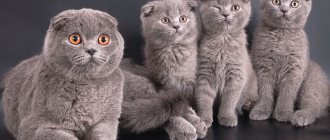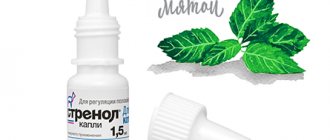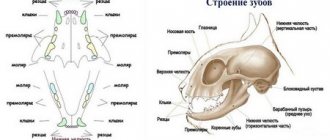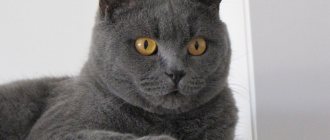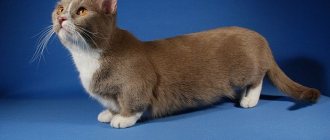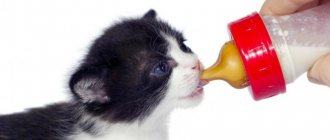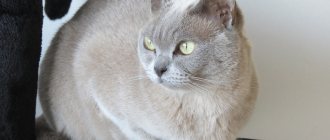Why does a cat lie on a person and why does it need it?
A cat next to its owner is always calm, but at the same time, some individuals believe that this way the person is under their complete control. Another version says that cats sleep either on people or on their things in order to absorb all the negativity and save the person from the disease.
Studies have shown that a cat is really able to determine a vulnerable spot on the human body, so it will lie down exactly where there is pain or body temperature is higher than normal.
Cats and people
Although they say about cats that they are animals that walk on their own, purrs love to feel like family members and take part, as far as possible for tailed cats, in everything that happens.
When a cat lies in the owner’s place, on his things, or jumps into his lap, he is sure that all events revolve around him, just as they do around other household members. In addition, these animals have a special sense of smell, thanks to which additional information is available to them.
https://youtu.be/r3AnfOs2d6c
About eliminating parasites in cats
Since uninvited guests are a common cause of this behavior, the owner should regularly administer antiparasitic therapy to the cat. This is the administration of anthelmintics to animals. You should not think that a pet that does not walk outside is safe from parasites. They can enter your pet's body through raw fish and meat. This food is not recommended by veterinarians, but many owners ignore such advice and spoil their animals. As a result, infection with helminths occurs.
The cat becomes lethargic, eats poorly, sleeps a lot, and loses weight. And the reason for this is parasites that feed on vitamins and nutrients from the animal’s blood. They inject their waste products into it, which further weakens the cat’s body.
So, veterinarians recommend carrying out anti-parasitic measures once every three months, regardless of whether the pet is walking outside or not. Most often, cats are prescribed the following anthelmintic drugs: Febtal, Prazicide, Polyvercan, Cestal Ket, Prazitel, Milbemax, Milprazone. These drugs allow you to rid your pet of uninvited guests within 24 hours and improve its general condition. But before using them, be sure to read the instructions and strictly follow the dosage.
It is better to treat worms in a cat on the weekend, so that he is under your supervision for 8 hours after consuming the antiparasitic drug. Sometimes the owner's help may be required if constipation suddenly occurs: then the cat needs to be given a laxative.
Veterinarians advise carrying out anthelmintic therapy before vaccinating a cat. Then he will tolerate the vaccination more easily, and its side effects will be avoided.
An important aspect of antiparasitic therapy is proper care of the animal. This means, first of all, daily washing of the kitten's litter box with special products. Worm eggs and their larvae are very tenacious. Therefore, by going into a dirty litter box and licking its paws afterwards, a cat can become infected with helminths immediately after they are removed with tablets or solutions.
>Why do cats roll on the ground?
But they don't like hands
At the same time, if you stop somewhere, the Scot will not jump into your arms, but will sit next to you, like a faithful dog. The Scots generally do not like to be picked up, sat on laps and squeezed, and sometimes they do not even like to be stroked. These are quite freedom-loving cats.
However, many Scottish cats are much softer in this sense. Some of them love to sit in your arms and come on their own, while others can be taken like a plush toy and squeezed, squeezed, squeezed... And he won’t leave. Such Scots are becoming more common now, because breeders are trying to include affectionate animals in their breeding.
What do fold cats, cats and kittens love?
Each cat has its own preferences. In addition to playing, sleeping and eating, many Scottish cats love communication and affection. However, there are also phlegmatic introverts who adore solitude.
In addition, the Scots love to sit on the window and watch what is happening there. And if a fly flies in, the cat will definitely go after it.
The Scots also love cardboard boxes in which they can hide.
This often looks funny and amusing, but in fact hides a problem. And of course, the cat is not doing this to cause mischief, so there is no need to scold her.
So, let's look at the main reasons.
The cat rides on its butt because the anal glands are clogged
If a cat rides on his butt, don't scold him, he doesn't do it out of spite
This is the most common reason for this behavior.
The anal glands in cats are located inside the anus. They secrete a very smelly liquid secretion.
Usually this secretion is released on its own and little by little when the cat goes to the toilet. Nature intended this to mark the territory.
But sometimes it happens that the secretion becomes viscous, thick and clogs the gland. The animal feels discomfort and even pain.
To release secretions and cleanse the glands, the cat may begin to ride on its butt. Often these attempts are unsuccessful, and you will have to clean the glands yourself or take your cat to the vet.
Possible pathological disorders
Unfortunately, diarrhea and dirty fur are not the only factors that cause a cat to ride on its butt. There are also more serious factors that lead to this behavior, for example:
- mental health disorder;
- post-traumatic stress disorder;
- helminthic infestation;
- paraanal inflammation.
Each of the diseases deserves attention and requires consultation with a veterinarian. In addition, they are accompanied by other symptoms, in addition to “travels on the fifth point”.
Signs of mental disorder
With mental disorders caused by stress, the pet's behavior changes noticeably and becomes strange. The cat can:
- show aggression;
- avoid communication, including with the owner;
- lose appetite.
The owner may notice that the pet begins to crawl on the floor, regardless of toilet procedures. In this case, it is recommended to immediately contact a specialist who will identify the pathology and prescribe appropriate therapy.
Phantom pain syndrome
After an injury to the hind legs or a fracture of the hip joint, the pet begins to look for a way to eliminate phantom soreness. He rolls on the floor, trying to get rid of the pain that is lingering in his brain. In such a situation, veterinarians prescribe medications that have a mild sedative effect to the animal. They help him cope with excruciating post-traumatic discomfort.
Parasite infestation
Most often, pets get pinworms and tapeworms, which live in the large intestine. To reproduce, many of them have to crawl to the entrance to the anus to lay eggs. This process is accompanied by a feeling of severe itching, which the pet tries to get rid of by crawling on the floor.
When infected with tapeworms, a feeling of bloating occurs in the intestines. The cat strives to get rid of feces, stimulating the anus while riding on the floor and causing defecation. To save your pet from such difficulties, you should regularly deworm it, using anthelmintic drugs for preventive purposes. These can be tablets for oral administration, drops on the withers area or other means.
Blockage of the anal glands
Mustachioed striped animals have anal glands, which are muscular sacs located in close proximity to the anus. They constantly produce secretions that are released through the ducts during bowel movements. It gives feces and urine a specific odor, allowing cats to leave “fragrant” marks on their territory.
Norm and deviations. In its normal state, the secretion is a thick, odorous substance. If the glands are not completely emptied, then corresponding disorders arise:
- the tissues of the muscle sacs are “overstretched”;
- irritation occurs in the glandular ducts;
- dermatological problems arise - small inflamed seals and bald spots form in the neck and along the spine;
- the paraanal glands swell greatly and become visible under the animal’s tail.
Consequences. If the owner does not pay attention to the blockage in time, then the disruption of circulation ends with the formation of a fistula and the penetration of the contents of the glands into the peritoneum.
The cat rides on his butt: the reason is that he attracts attention
Butt riding can be purely a behavioral problem. If this is not the first time your cat has done this and once upon a time he really had objective problems, and you ran around his butt as if stung, then perhaps in this way the cat is now attracting attention to himself. This means that the cat really needs communication, which you are not giving it. In this case, pet the cat and talk to him. Do this regularly. If after that he stopped driving in fifth place, then the reason was most likely a lack of attention.
The cat rides on his butt: the reason is that he swallowed something
If your cat rides on his butt, this is in any case a reason to look under his tail. Perhaps he is trying to get rid of something that just can't come out. For example, from thread, rain or polyethylene. If this is the case and the foreign object is sticking out of the butt, very carefully remove it. But if it's Christmas tree rain, it can damage the intestines like a blade. Therefore, the rain cannot be delayed, you can only cut it off and wait until the next portion comes out on its own.
After removing the foreign object, monitor the cat's stool: if there is blood in it, this is a reason to contact the veterinarian, because blood may indicate internal bleeding.
Ambassador: One morning my fat man started riding on his butt. (I have short hair, and the undertail is kind of neat, it doesn’t get dirty.) I’m shocked. Well, I think it's fucked up. Worms. Then the cat stood up, and there was something long sticking out of his ass!!!!! I'm totally panicking!! I take a glove, well, I think I’ll pull out the asshole worm. Not so. The cat screamed and ran away... Then he comes back happy. I look: there is nothing. I go out into the kitchen and see “IT” on the floor. I approach carefully, look... and this is an ordinary thread!!!!!! My friend ate the curtains and ate the thread.
What should you not be afraid of?
It would be correct to recommend being wary of any symptoms that make it painful for a cat to sit on its butt. But, before drawing any conclusions, you need to carefully examine the animal for obvious signs of the source of pain. If none are found, then you can feel the places that are a potential source of pain. If the animal behaves restlessly when pressing on the tail or back of the thigh, then the reason may lie in the following problems:
- Injury. Which an animal can get while playing with other animals, climbing trees or tall grass. This is especially true for places that bear the maximum load while sitting. You can tell that your pet has problems by its restless behavior and increased attention to the problem area. Most often this manifests itself in constant licking of the damaged area. If possible, it is necessary to treat the wound with an antiseptic and cover it with a bandage so that the pet cannot lick it. This will speed up healing. If the wound does not heal for a long time, constantly bleeds or begins to fester, then it is better to see a veterinarian, as antibiotic therapy and the selection of effective anti-inflammatory and healing ointments may be required.
- Foreign body. A splinter made of wood, metal or plastic can get into the back of the thigh or buttock area. We are talking about wood chips from the floor (if the house has parquet), metal shavings or plastic fragments. Any of these items can provoke an inflammatory process if it gets under the skin of an animal. Therefore, if it hurts a cat to sit on its butt, then you should carefully examine it for splinters, especially when there are plants with thorns (cacti) in the house. Large splinters can be removed independently using tweezers, and the wound after removing the foreign body must be treated with miramistine or chlorhexidine. This will not work with small splinters, especially when the suppuration process has begun. It is best to see a veterinarian about this problem, since in addition to opening the abscess, you will also need to clean it and remove the splinter using special gripping tools.
Under favorable circumstances, the events described above do not pose a serious threat to the health of the animal.
What living conditions do Scottish Fold cats require?
Representatives of this breed will be quite comfortable within the walls of an ordinary apartment. The main thing is to give them their own secluded place where the cat can spend time alone with itself. In this case, the bed should be located away from drafts that are dangerous for Scottish Folds.
Protect your pet from drafts /
For the safety of the animal, it is advisable to install special protective nets on the windows. If they are not there, the cat may fall out of the window when trying to catch a bird or a falling leaf.
It’s worth taking care of your cat’s leisure time. In addition to a sleeping place and a tray, a Scotsman definitely needs a scratching post. With its help, he will be able to put his paws in order and will not encroach on your furniture.
Diversify your pet's leisure time. belchonock / Depositphotos.com
Balls, mice and other toys will help diversify the life of the Scottish Fold cat. You can also install an entire play center, which will also provide additional physical activity for the cats and maintain their physical fitness.
Scots can be called homebody cats. However, if your cat feels calm and comfortable in the fresh air, take him on short promenades or let him out into his own garden. At the same time, walking Scottish Folds should not be left unattended for a long time.
Poor diet and low mobility
Common factors leading to butt riding include:
- physical inactivity;
- excess body weight;
- high-calorie foods.
Unfortunately, even among cats there are often lazy people who lead a sedentary lifestyle. With obesity and low activity, changes occur in the animal’s body and the place of muscles is replaced by a fat layer. The tissues are compressed and the circulation of the anal ducts is disrupted.
Excess calories affect the functions of internal organs, which leads to the development of diarrhea. With frequent bowel movements, the odorous secretion does not mix with feces, remaining on the skin, causing irritation and itching. And in this case, the pet will ride on the floor, trying to reduce discomfort.
Metabolic disorder
Failures in metabolic processes lead to various disturbances in the functioning of the animal’s body. As a result, the consistency of secretory secretions often changes; they can become too thick and clog the ducts. Sometimes the glands begin to secrete more secretions than usual. In both cases, the skin becomes irritated, inflammation, swelling and itching occur. If the pet is not helped, then the risks of developing complications are high:
- The animal begins to actively move along the floor, which causes damage to the skin near the anus.
- The wounds become infected and an inflammatory process develops. The most dangerous thing is infection of ulceration by pathogenic bacteria.
- If left untreated, the inflammatory process spreads to the peritoneum.
How to feed Scottish Fold cats
The easiest way is to stick to ready-made wet and dry food. It is better to choose from lines of proven brands, because only high-quality complete food provides the animal with all the necessary proteins, fats, carbohydrates, microelements and vitamins. In addition, you can sometimes give healthy treats that not only help diversify the menu, but also, for example, help clean the animal’s teeth.
Select a ready-made diet taking into account the characteristics of the animal - age, health status and the presence of chronic diseases, sterilization, pregnancy and lactation.
Another option is natural products such as meat and offal, cereals. But ordinary food from the human table is prohibited for the Scots. It simply will not provide the cat’s body with everything it needs, and sometimes it can even pose a danger to their life.
The food on our table is not suitable for cats.
When deciding what to feed your Scottish Fold, consider what kind of food he was accustomed to while he lived with the breeder. A sudden change will not benefit the animal, and the kitten may simply refuse unusual food. Even if you decide to change your diet, you need to do it gradually.
Representatives of this breed are often prone to obesity. This must be taken into account when planning your diet. You should not overfeed your pet, as obesity can lead to a number of health problems.
Learn
